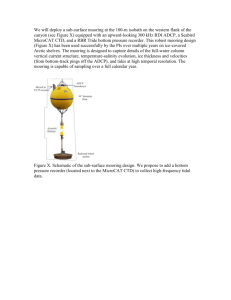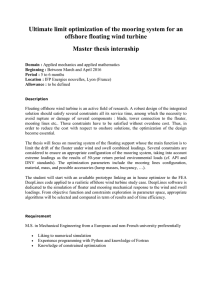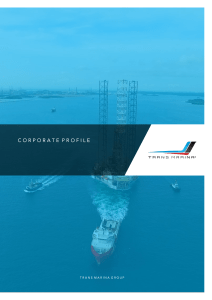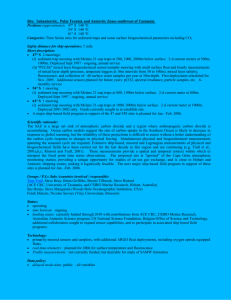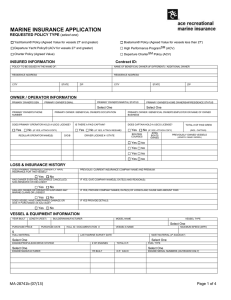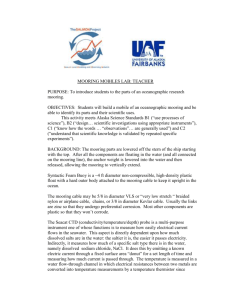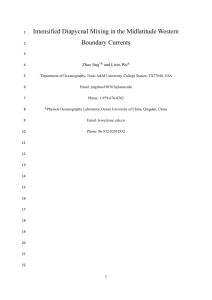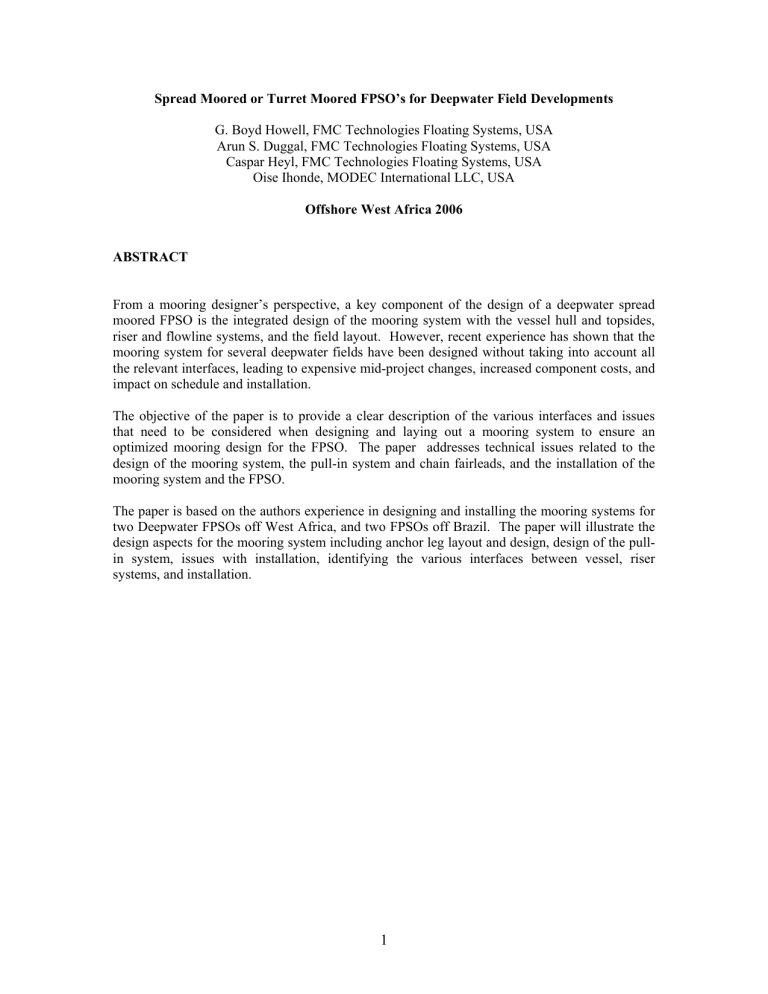
Spread Moored or Turret Moored FPSO’s for Deepwater Field Developments
G. Boyd Howell, FMC Technologies Floating Systems, USA
Arun S. Duggal, FMC Technologies Floating Systems, USA
Caspar Heyl, FMC Technologies Floating Systems, USA
Oise Ihonde, MODEC International LLC, USA
Offshore West Africa 2006
ABSTRACT
From a mooring designer’s perspective, a key component of the design of a deepwater spread
moored FPSO is the integrated design of the mooring system with the vessel hull and topsides,
riser and flowline systems, and the field layout. However, recent experience has shown that the
mooring system for several deepwater fields have been designed without taking into account all
the relevant interfaces, leading to expensive mid-project changes, increased component costs, and
impact on schedule and installation.
The objective of the paper is to provide a clear description of the various interfaces and issues
that need to be considered when designing and laying out a mooring system to ensure an
optimized mooring design for the FPSO. The paper addresses technical issues related to the
design of the mooring system, the pull-in system and chain fairleads, and the installation of the
mooring system and the FPSO.
The paper is based on the authors experience in designing and installing the mooring systems for
two Deepwater FPSOs off West Africa, and two FPSOs off Brazil. The paper will illustrate the
design aspects for the mooring system including anchor leg layout and design, design of the pullin system, issues with installation, identifying the various interfaces between vessel, riser
systems, and installation.
1
2
INTRODUCTION
Deepwater oil fields are becoming more and more common and the use of a Floating (Production)
Storage and Offloading systems (FPSOs) provide a mature technology for the production, storage
and export of hydrocarbon products from these areas. FPSOs have been installed in a variety of
configurations over the past thirty years. In general there are two options for mooring systems,
either spread moored or turret moored.
A spread moored FPSO involves a vessel moored by anchor legs from the bow and stern of the
vessel in a four-group arrangement. The risers that transport the products to and from the vessel
are suspended from “riser porches” on the side of the vessel. This type of mooring system
maintains the vessel in a fixed orientation of the F(P)SO in global coordinates.
A turret moored FPSO is designed as a Single Point Mooring (SPM) that allows the FPSO to
weathervane about the mooring system, in response to the environment. This weathervaning
ability allows the vessel to adapt its orientation with respect to the prevailing environmental
direction to reduce the relative vessel-environment angles and the resulting load on the mooring.
This also allows for a more optimum offloading orientation than that with a spread moored
system. The riser systems are also supported within the turret structure.
This paper compares the two FPSO systems by providing a description of the unique
characteristics of the two mooring systems. This paper will not address the actual cost estimate or
comparison between the two types of systems. A realistic comparison can only be performed for
an actual field development where the basis design parameters are better known. There are many
factors which influence the selection of a mooring system. These factors include details of the
vessel, the environment, the subsea field architecture, the topsides equipment layout and the oil
offloading requirements.
The paper is divided into three sections:
• General comparison between turret and spead moored system
• Design and characteristics of atypical mooring system for Brazil
• Design and charactersistics of a typical spread mooring system for West Aftrica
In conclusion the authors wish to show that in making the decision on which type of mooring
system is best suited for a particular application all relevant factors should be considered. Often
the decision can be swayed by incorrect application of one or more factors. In general it is
possible to design either type of system for most applications, bearing in mind the preferences of
the owners/operators.
COMPARISON BETWEEN TURRET AND SPREAD MOORED SYSTEMS
Turret Moored Systems
Two types of turret systems are commonly used for F(P)SOs – the internal turret system where
the turret is mounted within the F(P)SO hull, and an external turret system where the turret is
mounted on an extended structure cantilevered off the vessel bow.
An FPSO turret system is a compact multi-functional structure that includes many stand-alone
sub-systems found on other moored floating systems. The turret integrates the F(P)SO mooring
system, the installation equipment for the anchor legs and the risers, the fluid-transfer system
3
including riser support, manifold, pig launching and receiving, metering, chemical injection, and
subsea control systems into one compact, self-contained module.
Figure 3 provides an illustration of the internal turret mooring system developed for the
Barracuda early production system (P-34) in the Campos basin, offshore Brazil. This turret
system was designed for 34 risers in water depth of 835 meters and installed in a converted
50,000 DWT tanker. The figure provides a good illustration of the various sub-systems and their
typical arrangement within the internal turret mooring system. Since then FTI has completed an
additional 10 turret moored F(P)SO projects.
The mooring system of the internal turret includes the anchor legs, the turret shaft and the bearing
system. The turret provides the load-transfer mechanism between the mooring and the vessel and
also provides the mechanism for the weathervaning capability of the turret mooring system. The
fluid-transfer system includes the support for the risers, the manifold, the injection, and the swivel
stack systems that allow transfer of the fluids from the earth-fixed turret and risers to the
weathervaning ship-fixed production system. In addition, the turret may include the installation
system comprised of winches and sheaves.
The 360-degree weathervaning feature of a turret moored F(P)SO significantly reduces the impact
of greenwater on the vessel deck and production equipment and wave-frequency vessel motions,
affecting both crew comfort and production plant uptime. As the F(P)SO maintains a heading into
the predominant environment, greenwater is generally limited to the area forward of the turret and
away from process and other key main deck systems. Also, vessel motions, particularly rolling
motions, are typically reduced thus allowing more operating uptime during inclement weather
conditions. This weathervaning ability is very important for the offloading operation as the
headings of the F(P)SO and the export tanker are both into the predominant sea or winds, thus
creating safer approaches and alignments during offloading operations. As the risers are
contained within the turret structure, offloading operations are simplified as the F(P)SO hull is
uncluttered with risers or exposed mooring lines.
4
Swivel Stack (Product/Lift/Controls)
Manifolds & Pig Launching/
Receiving
ESD Valves, Injection Skids
Anchor Leg & Riser Installation
Equipment
Bearing
Turret Shaft/Riser Guide Tubes
Chain Table (Hawse Pipes/
Chain Supports)
6 Anchor Legs + 34 Risers
Figure 3: The P-34 Internal Turret Mooring System.
For a turret system, anchor legs may be arranged symmetrically or grouped in multiple sets of
three or more legs such that openings between sets allow for varied and more direct riser
approaches to their connections on the base of the turret. This “direct approach” may allow for
more economical seabed flowline arrangements by eliminating loop routings around anchor leg
arrays. In addition, turret mooring systems typically have fewer anchor legs of smaller component
size than a mooring system for an equivalent spread moored F(P)SO.
Until recently, internal turrets were assumed to be limited to 40 or so risers before the cost and
turret congestion became unmanageable. Now, new and cost-effective turret designs can
accommodate up to 100 or more risers in water depths ranging up to 2000 meters or more.
Various designs for lower-cost external turret systems permit up to 40 or more risers for
deepwater activities.
Spread Mooring Systems
Spread mooring or Multi-Point Mooring (MPM) systems have long been the traditional means of
mooring all kinds of ships and barges in open and protected waters. For this type of mooring,
multiple anchor lines extend from the bow and stern of the hull and anchor the unit to the seafloor
in a fixed or slightly variable heading. Spread mooring systems can be designed for shallow or
deepwater stationkeeping, in mild to moderate environments. The performance of the spread
moored system is dependent on the prevailing weather and it is considered suitable for regions
with a fairly restricted range of weather direction. They are not so effective, however, in harsh or
5
multi-directional environments where changing wind, waves and currents may impose severe
loads on the anchoring system and create excessive motions on the unit. It is also important to
consider the feasibility of offloading as a function of the day-to-day environment taking into
account the approach and offloading operations with the export tanker.
Figure 2 provides an illustration of a typical, large-field, spread moored F(P)SO system. The
figure also indicates the various sub-systems identified within the turret mooring system and their
typical location on the spread moored F(P)SO. Note how the various sub-systems are distributed
about the deck of the F(P)SO. Also note the increasing complexity of the on-deck arrangement of
the various F(P)SO systems that require additional interfaces between the various providers of
design and equipment. All of these sub-systems must be accounted for in the CAPEX of a spread
moored system when compared to that for a turret mooring system.
For deepwater spread moored F(P)SO units, the number of anchor legs required may range
between 12 and 20 lines, compared to 6 to 12 anchor legs for a turret moored system.
Riser attachments for spread moored F(P)SO units are commonly located on “porches” installed
along the length of the F(P)SO hull. The ability of a spread moored F(P)SO to accommodate a
large number of risers (100 or more) provides the operator with additional flexibility with regards
for installation, expansion and a more direct connection to individual wells by minimizing subsea
manifolding.
For many large spread moored F(P)SOs, the mooring system installation requires separate
winches for the forward and aft anchor legs with a system of sheaves to allow access to each
fairlead. This adds to the congestion on the deck and becomes a major interface requirement for
the topsides arrangement for the ship and production systems of the vessel. The riser system
typically requires its own winch and sheave arrangement.
Anchor leg and riser arrangements for the spread moored F(P)SO often impact both the subsea
arrangement of the flowlines and the selection of the offloading system. In order to limit the
possibility of an anchor leg breaking and falling onto a subsea flowline, the flowlines are
generally routed around the seabed anchor arrays so the risers approach the F(P)SO perpendicular
to the riser porches. For safer operations, dual offloading systems on the vessel bow and stern to
accommodate export tankers during changing environmental directions may be used, or even
satellite export systems may be installed that move the offloading activities away from the
F(P)SO system. Specialized dynamically positioned export tankers also may be also used for
offloading from a spread moored F(P)SO.
6
Mooring/Riser
Pull-In Equipment
Manifolds
Pig Launching/Receiving
Subsea Control
Risers
Anchor Legs
Figure 2: Typical Large-Field New-build F(P)SO System.
For the West African market FTI & MODEC combined have designed and installed 3 spread
mooring systems and 2 External Turrets.
Likewise, in the Brazilian arena FTI and MODEC have combined for 2 Internal Turret Moored
systems, 2 External Turret Moored Systems and 1 Spread Moored system.
The decision on which type of system to use for each of these projects was partly driven by
company preference and partly by technical requirements.
For projects with 100 risers or more, the likely solution will be a spread mooring, whereas for up
to 30 risers the turret moored solution will most likely dominate. When making a decision of the
type of system it is important to consider both CAPEX and OPEX of the complete system and not
just the FPSO itself. The FPSO CAPEX, The offloading system CAEX, Offlaoding system
availability and operational constraints must be addressed also.
Possible Offloading Scenarios
An important difference between a turret moored and spread moored F(P)SO system is the
reliability and ease of use of the offloading operation. The choice of F(P)SO mooring systems can
impact the reliability and equipment used for offloading liquid product from the unit. The
offloading technique may be one or more of the following methods and is a function of whether
the export tanker is a vessel of opportunity or from a dedicated tanker fleet.
7
Tandem Offloading: The export tanker approaches forward or aft of the F(P)SO, depending on
sea and environmental conditions. It is then “tethered” by a hawser line downstream from the
F(P)SO unit. Floating hoses from the F(P)SO are connected to the export tanker’s manifold, and
the product is transferred between the two units. Typically one to two assist tugs are used to keep
tension on the hawser to maintain the tanker relative alignment with the F(P)SO and to prevent
the tanker migration towards the F(P)SO during benign or changing sea conditions. This is the
most common and preferred offloading arrangement for all F(P)SOs. It is a well-established
offloading method in use at marine terminals and F(P)SOs for several decades and utilizes
standard OCIMF equipment. In some regions of the world, dynamically positioned shuttle tankers
are used that do not require assist tugs to maintain position during offloading. However, they are
typically dedicated to a region or group of fields, and this “dedicated” feature reduces the
favorable economics associated with the use of “tankers of opportunity” for offloading F(P)SO
units. The overall field CAPEX and OPEX also increases substantially because of the investment,
operating and maintenance costs associated with the dedicated tanker fleet.
Satellite Offloading: A deepwater CALM buoy or other terminal structure is positioned some
distance away from the F(P)SO unit (approximately one nautical mile). Flowlines are connected
between the two facilities to allow the transfer of product to the export tanker moored to the
terminal. While this distances the offloading operations from the F(P)SO, and provides excellent
uptime over the life of the field, it also adds significant cost to the overall project for the installed
buoy and flowlines, and the additional power and pumping requirements on board the F(P)SO.
Side-by-Side Offloading: The export tanker is moored abreast of the F(P)SO and hoses or
Chiksan loading arms are connected between both vessels to transfer the product. For spread
moored F(P)SO units, this offloading method can be complicated as the export tanker must
carefully navigate between the bow and stern anchor patterns to avoid collision with the hull or
legs or risers (if nearby). This method of offloading is not very common for deepwater field
developments because of the inherent risks.
For spread moored F(P)SO systems, side-by-side and tandem offloading creates a high degree of
exposure to collision as the F(P)SO remains fixed in position as the export tanker maneuvers
about it. For a turret moor F(P)SO system, side-by-side and tandem operations are simplified as
the unit’s beams are uncluttered with risers or exposed mooring lines, however, the offloading
system of choice is the tandem offloading for both tankers of opportunity or DP shuttle tankers.
Also, the headings of the F(P)SO and the export tanker are both into the predominant sea or
winds, thus creating safer approaches. For safer operations, expensive satellite export systems
may be rationalized for spread moored F(P)SO units yet remain a debatable option for turret
moored F(P)SO offloading.
Pros and Cons of the Two Mooring Systems
The description of the two mooring systems has highlighted many of the differences between a
turret moored and spread moored system in terms of design and performance. Table 1 provides a
comparative summary between the two systems that illustrates the differences discussed above.
As discussed earlier, turret moored systems orient themselves to the prevailing environment
direction that allows its use in harsh, multi-directional environments with minimized loads and
vessel motions. A not so obvious advantage of a weathervaning turret mooring system is that as it
adjusts itself to the prevailing environment it is not as sensitive to poor design environmental
criteria which is common in areas where new development takes place. A spread moored system
is moored in a fixed orientation and thus is more sensitive to global environment intensity and
direction. The turret system provides a compact load and fluid-transfer system with a minimum
8
number of anchor legs required. The weathervaning ability helps provide more constant
offloading conditions for export tankers, helicopter operations, and discharges from flares.
However, the passive weathervaning ability of the turret mooring system requires the location of
the turret at the vessel bow that is the location of the maximum vessel motions and thus requires a
riser system that is robust enough to withstand the motions at the turret. A turret mooring system
is not readily adapted to the addition/modification of riser systems (needs to be designed in to the
system), and its design and fabrication requires specialized engineering and manufacturing
techniques and knowledge.
9
Table 1: Comparative Summary of Turret Moored and Spread Moored F(P)SO Systems.
Turret-Moored
Vessel Orientation
Environment
Field Layout
Riser Number & Arrangement
Riser Systems
Stationkeeping Performance
Vessel Motions
Vessel Arrangement
Offloading Performance
Spread-Moored
360 degree weathervaning
Fixed orientation, can impact flare
Mild to extreme,
Mild to moderate,
directional to spread
uni- to fairly directional
Fairly adaptable, partial to
Prefers flowline arrangement to
distributed flowline arrangements
approach beam-on
Requires commitment,
Can be designed for flexibility,
moderate expansion capability
additional tie-ins
Location of turret (bow) requires
Adapts to various riser systems,
robust riser design
combinations of various types
Number of anchor legs,
Larger number of anchor legs,
offsets minimized
offsets variable
Weathervaning capability
Dependent on relative vessel/
reduces motions
environment directionality
Turret provides "compact"
Components spread on deck,
load and fluid transfer system
requires extensive interfaces
FPSO typically aligned with
Dependent on vessel/
mean environment
environment orientation
An important aspect to consider with spread moored vessels is the offloading performance of the
system over the life of the field. As the vessel orientation is fixed, a tandem moored export tanker
has a limited range of relative heading with respect to the F(P)SO when tandem offloading from
the vessel, especially in inclement weather, not directly aligned with the F(P)SO orientation. In
order to maintain the shuttle within this allowable zone additional tug assistance may be required
as compared to a similar turret moored system, or a second offloading station may be required at
the other end of the F(P)SO to improve the offloading uptime. The environment mis-alignment
with the F(P)SO orientation can also lead to difficulties in approaching and leaving the F(P)SO
before and after the offloading of product.
In extreme cases where the use of a spread moored system and multi-directional environmental
conditions does not provide the desired uptime for tandem offloading, a satellite offloading
station may be installed approximately one nautical mile from the F(P)SO. In deepwater,
flowlines are suspended between the F(P)SO and the remote offloading station (typically a large
CALM buoy).
Considering the basis of design for the development, the various sub-systems and components
can be addressed and a comparison between the two mooring types, including engineering,
management, and fabrication/assembly costs can be made.
The capital costs (CAPEX) of the two systems
•
Moorings: This includes all systems of the mooring to vessel load-transfer system
including anchor leg components, fairleads and chainstoppers, the turret structure,
mooring installation equipment, etc.
10
•
Fluid-Transfer: This includes all equipment required for fluid-transfer from the risers to
the topsides production stream. This includes the riser porches, manifolding, pig
launching and receiving, swivel stack, riser specific installation equipment, etc.
•
Hull Modifications: This group includes mooring system specific modifications for the
hull, e.g., the turret moonpool, underwater fairlead supports, bending shoes, bilge keels,
etc.
•
Topsides Systems: This includes equipment specific to topside system cost due to
mooring system selection, e.g. metering, chemical injection skids, electrical and
hydraulic systems that may be located in a turret system, modifications to topsides to
accommodate the selection of either system, etc.
•
Offloading System: This includes the specific offloading system components required for
each mooring system type. This includes offloading system related equipment on board
the vessel and remote offloading systems and associated flowlines if required.
•
Installation: This includes all installation costs to installing and hook-up the FPSO to its
moorings and remote offloading system if required.
•
Services and Administration: This includes all engineering, management, procurement
and mark-up costs associated with the spread moored or turret moored specific items
described above.
The operational costs (OPEX) of the two systems
•
Demurrage: Tanker demurrage time and charges.
•
Maintenance and Inspection: This includes all maintenance and inspection requirements
for the mooring system specific components including the requirements for a remote
offloading system if utilized.
•
Offloading Tugs and Pilots: This includes the costs for offloading assistance from support
vessels, and pilots required for navigation around the FPSO. The offloading costs are
developed to provide a relative offloading OPEX cost as this has been used to ensure
comparable offloading performance from both F(P)SOs.
•
Offloading Hoses and Hawsers: Replacement costs associated with replacing hoses and
hawsers with each system, based on standard industry practice.
Production loss due to excessive vessel motions is computed as a relative cost difference between
the spread moored and turret moored systems rather than the actual values for each system
obtained from the analysis. This minimizes the high sensitivity of the overall cost estimate to
production loss, compared to the CAPEX and OPEX costs associated with the two systems.
The Present Value (PV) of the two systems serves as a method of comparing the total cost of the
mooring systems on the same time reference, accounting for inflation and the present value of
future expenses. The PV for each case study is based on a 10.5% discount rate computed from the
first oil milestone.
11
Figure 9: Illustration of a large capacity internal turret for offshore Brazil.
.
Services &
Administrative
Mooring
Installation
Offloading
System
Hull Systems
Spread Mooring
Fluid Transfer
Topside
Systems
Services &
Administrative
Installation
Mooring
Offloading
System
Turret Mooring
Hull Systems
Topside
Systems
Fluid Transfer
Comparison between a spread moored and a turret moored FPSO in Brazil.
12
Flowlines
A long standing misconception is the capacity of turret mooring systems to support large number
of risers. FMC Technologies has developed large internal turret systems that are capable of
supporting over a 100 risers. Because of the reduced number of anchor legs and anchor leg
groups required for a turret mooring system, a turret mooring system will have more seabed area
available between the mooring lines on the seabed [1]. Recently FMC Technologies proposed an
external turret solution accommodating 33 risers for use on the Frade field in 1,000 meters of
water in the Campos basin. Figure 1 illustrates the arrangement if risers on an external turret.
Both turret moorings and spread moorings are expandable, but require planning for additional
risers during the initial construction. In the case of a turret mooring, slots for additional future
risers need to be arranged in the turret. In the case of a spread mooring, provisions for additional
risers will have to be made in the riser porch structures, at deck level and at or near keel level.
General Layout of mooring system and flowlines
During the initial phase of the project, thought must be given to the way that flowlines are routed
on the seabed. Typically, mooring arrangements are determined in a FEED study phase using
results from preliminary mooring analysis to determine mooring system characteristics such as
the number of mooring lines, the mooring line plan angles and anchor radius. More detailed
mooring analysis, in particular the verification of the minimum fatigue life at a later stage may
indicate that a much larger chain size is needed to satisfy fatigue life design criteria. The results
of a detailed study that investigated the effect of mooring system footprint on the fatigue
resistance of the mooring system indicate that these changes could have been prevented if a
fatigue analysis had been performed as part of the FEED study [2].
The layout of the mooring lines and flowlines on the seabed can also have a significant effect on
the feasibility of the selected riser system. During the detailed riser analysis for a recently
installed spread mooring project in Brazil it was found that for the risers to work in a catenary
configuration, the vessel offsets needed to be kept below 8% [3]. This offset limitation is below
the maximum offset criteria of 10% that is typically given to the mooring designer. Because the
mooring design typically precedes the detailed riser analysis by 12 months or more, this can
create a situation whereby it becomes desirable to make changes to the mooring design late in the
project while the mooring line components are being manufactured.
Vessel Motions
Extreme roll motions are greater for a spread moored FPSO since maximum beam sea condition
is a 7 meter significant sea. Since the wind wave and current systems in the Campos basin are not
strongly correlated, large angles between vessel and waves can also occur for turret moored
FPSOs albeit for reduced wave heights. However, in recent years, Petrobras has increased the
design significant wave height to be used for beam sea conditions for turret moored FPSO’s from
3.5 to 5.7 meters. The result of this is that maximum roll angles for spread moored and turret
moored FPSOs are getting closer. In the Campos Basin, both spread moored and turret moored
FPSO are fitted with extra wide bilge keels (1-1.5meters) to keep extreme roll motions to below
10 degrees. Figure 2 shows a model of an FPSO in Campos Basin beam sea conditions. Because
of the significant beam sea conditions (up to a significant wave height of 7 meters with a
relatively short spectral peak period) vertical accelerations along the side of a spread moor can be
higher than those at the turret location for an internal or even external turret.
13
A comparison between two recent model test campaigns carried out by FMC Technologies
showed that maximum vertical accelerations near the riser hang-off locations on a spread moored
FPSO were actually higher (3.2 m/s2) than those measured on for an FPSO with an external turret
mooring (2.1 m/s2). In addition, the large beam sea condition can lead to wave slamming issues
on the riser balcony along the side of the vessel in the full draft condition. Figure 3 shows wave
slamming around the riser porch area observed during FPSO model tests.
Offloading availability
Currently there are far more turret moored FPSOs in the Campos Basin than Spread Moored, but
of the last nine FPSO projects in the Campos Basin, five use a spread mooring. From this recent
experience with spread moorings it is becoming clear that in the Campos Basin, offloading
availability for a spread moored FPSO is lower than for a turret moored FPSO even when one
takes into account that the spread moored FPSOs have offloading stations on both the bow and
the stern. The difference in operability of the export system between spread mooring and turret
mooring is even greater in West Africa where most large FPSOs are installed with a separate
single point mooring for the purpose of exporting crude.
Mooring system Design.
One of the main differences between the Campos Basin in Brazil and West Africa is the
environment. In West Africa, the largest waves are limited to a narrow 45-degree sector centered
around South-Southwest, while in Brazil, severe wave conditions approach the platforms from a
90-degree sector between Southwest and Southeast. The result for a spread mooring system is
that in Brazil large wave conditions are encountered at large angles to the bow of the vessel,
which result in larger mooring loads. Using a turret mooring system will reduce the relative wave
angles for the larger sea states and result in smaller mooring components. From recent project
experience it was found that in the Campos Basin, for a given water depth, the mooring system
for a turret mooring used only half as many mooring lines (9) as a spread mooring (18), and that
at the same time the breaking strength of the mooring lines used on the turret mooring (750
metric tons) was half of those needed for the spread mooring (1500 metric tons).
14
Figure 1 Example of riser arrangement on an external turret.
15
Figure 2. FPSO model test of Campos Basin beam sea
conditions
Figure 3. FPSO model test showing wave slamming on riser porch area.
Design and Characteristics of a Typical Spread-Mooring System for West Africa
Spreadmoored FPSOs are popular in West Africa due to the relatively benign and highly
directional wave environment, and the typical fields that have been developed. Large FPSOs
(typically 150,000 to 250,000 barrels of oil/day) also incorporate an offloading buoy and
associated flow lines to provide the desired uptime and reliability for offloading. For smaller
FPSO developments (around100,000 barrels of oil/day) a turret mooring system is considered an
optimum solution with tandem offloading from the stern of the FPSO. Tandem loading from
spreadmoored FPSOs are only considered to be an emergency option or used off very small
FPSOs (say up to 50,000 barrels of oil/day) where an average of one to two offloadings are
performed a month.
Optimization of the design of a spreadmooring for large West Africa FPSOs requires the
integration of the mooring design with major components of the FPSO system. Key interfaces
include the vessel hull and topsides, riser and flowline systems, and the field layout. The
following subsections detail the impact of the various design parameters on the mooring system:
•
•
•
•
•
•
Environmental Conditions
Field Layout
Performance Requirements
Integration with Hull and Topsides
Impact of Risers and Oil Offloading Lines
Installation & Hook-up
16
Environmental Conditions
The environment offshore West Africa can be characterized by persistent long-period swells from
the SSW with uncorrelated low-intensity wind and current environments. The environment is also
characterized by squalls that are of short duration (typically one hour) and very high wind speeds
(5 sec gust greater than 30m/s). Squalls typically originate over land and propagate over the
ocean, but locally can be incident from almost any direction. These high wind speeds coupled
with the very large FPSO systems results in large vessel offsets and thus anchor leg tensions, and
typically govern the design of the mooring system from an extreme load and offset perspective.
As the vessel is typically oriented with its bow, or stern towards the SSW the loading from the
swell on the FPSO is minimized but due to its persistence results in defining the fatigue life of the
mooring system.
For the FPSOs with offloading buoys the buoys are typically located North of the FPSO to
optimize the approach and departure of the tankers of opportunity. However, the nature of the
environment can also lead to large crossed conditions (wind, waves and current from very
different directions) and thus result in the tanker orientation being quite varied.
Mooring System Design and Interface with Riser System
Mooring systems for spread-moored FPSOs offshore West Africa typically are designed as
grouped mooring systems with fairleads at the corners of the vessel. Typically the number of
anchor legs range from twelve to sixteen with three or four anchor legs in each group,
approximately 5 degrees apart. The anchor legs typically have a taut or semi-taut configuration
and constructed with chain and spiral strand wire or polyester rope. The mooring system is
anchored using suction embedded piles or vertically loaded anchors. For water depths greater
than 1,000 meters the fairlead to anchor horizontal distance is typically 1 - 2 times the water
depth. Typical maximum vessel offsets for an intact mooring system are 5% - 7% of water depth.
The layout of the mooring system during the FEED stage of the project is extremely important as
it plays a large role in determining the performance of the mooring and its cost and effectiveness
as changes to the mooring layout during detailed design is difficult to accomplish due maturation
of the subsea layout. It is quite typical in preliminary engineering to consider a symmetric
mooring arrangement with anchor points determined from a simple analysis or rule of thumb, but
experience has shown that insufficient attention to the mooring design at this stage can have a
detrimental impact on the system at a later stage.
One reason for this is that the mooring design must take into account the riser and oil offloading
lines (OOL) loads. Also experience has shown that the anchor legs towards the swell environment
(towards the SW) are also susceptible to fatigue damage and that increasing the distance to the
anchor (closer to 2 times the water depth) can result in much better mooring performance and
overall lower mooring costs.
Due to the weight and length of these OOLs, each OOL exerts a horizontal force on the FPSO
that is equivalent to that of an anchor leg. In addition the large FPSOs have a large number of
risers attached to the vessel that also exert large horizontal forces on the vessel. Summing up the
external forces from the OOLs and risers results in large surge and sway forces, and a yaw
moment that have to be counteracted by the mooring system in addition to the environmental
loads to maintain the vessel at the desired heading and position.
The asymmetry of the external forces caused by risers and the OOLs attached to one end of the
vessel result in the design of an asymmetric mooring system. The mooring asymmetry may either
17
be accomplished by varying the number of anchor legs in a group and/or varying the pre-tension
and anchor leg length. One characteristic of such a mooring is that the stiffness is also
asymmetric and thus for a given load, vessel offset will vary as a function of direction. The
mooring system is typically “softest” when offset away from the offloading buoy as the force
from the OOLs is fairly constant with offset. Another unusual characteristic of such an FPSO
mooring system is that the static equilibrium position of the FPSO may vary by 10 meters with
change in draft from ballast to fully loaded.
These response characteristics are extremely important when transferring design information to
the riser analysts and designers. The riser designs for spreadmoored FPSOs in deepwater have
very restrictive vessel offset requirements (typically 5% of water depth), especially if steel
catenary risers are used. Due to the yaw motions of the spread-moored vessel (especially in squall
environments) the design offsets of the vessel may vary by 50% depending on whether it is
attached near midships or near the bow/stern. This coupled with the asymmetric stiffness
characteristics of the mooring system requires a clear specification of vessel offset as a function
of the incident environment. This requires the mooring and riser designers to work closely in the
design phase to ensure that consistent environmental conditions and vessel response data is used
to design the riser system.
Integration with Hull and Topsides
The anchor leg fairleads can be either keel mounted or deck mounted depending on project
construction and operational requirements. The selection of fairlead type can have a large impact
on the hull construction. Keel mounted fairleads are more complex and need to be installed in dry
dock and the arrangement/number/size must be determined fairly early in the project design cycle
to ensure proper integration with the hull. Deck mounted fairleads are typically simpler and are
mounted on the main deck with stiffeners to support them and can be installed at any time during
the hull/topsides fabrication. The keel mounted fairleads provide clear access on both sides of the
vessel while deck mounted fairleads restrict the access to the vessel sides. Keel mounted fairleads
may also require guide tubes for the chain from the keel to the main deck.
The fairlead arrangement also impacts the design of the pull-in system that could be a winch,
chain jack or combination. For spread moorings (in contrast to turret systems) the pull-in system
can take a large amount of real estate on the deck and the design of the pull-in system must
consider the topsides arrangement, the location of structural supports and marine equipment on
the deck, and other obstructions. The retrieval lines are directed to the various fairleads using a
series of sheaves that also take a lot of real estate on the deck and need to be supported. The
mooring pull-in system may also be used to pull-in the riser and oil offloading lines and thus
requires a fairly good definition of all the risers and their locations.
Mooring System Installation and FPSO Hook-up
Installation of deepwater mooring systems presents numerous technical challenges both in terms
of installing the individual anchor legs and in hooking up the vessel. This is further complicated
in West Africa due to the presence of persistent swell and the unpredictable nature and intensity
of West African squalls.
Unlike other regions of the world where there exist periods where the seas are relatively calm due
to the small wave heights and short wave periods, the long period swell results in the installation
vessels undergoing relatively large heave and pitch motions that results in increased dynamics
during lifting and lowering operations. Most permanent mooring systems in West Africa are
anchored using suction piles that may weight 150 – 175 MT. During the lowering operation a
vessel heave of 1 meter amplitude can result in the suction pile heaving +/- 4 meters due to the
18
dynamics in the system with large velocities – greater than 1 m/s. This can result in large winch
line tensions and can result in instability while setting down the pile as well as permanently
disturbing the soil in which it is being installed. For a stable and controlled installation, typical
penetration velocities need to be 0.25 m/s or less and require the use of active or passive heave
compensation and large vents on the pile top to allow water to discharge during self-penetration
without blowing out the soil around the pile.
Another installation challenge is to install the mooring system without inducing twist in to the
anchor leg and to ensure no damage to the spiral strand wire or polyester rope which has been a
recurring problem on deepwater mooring system installations. Mooring line twist can be
minimized if a low rotation rope (and definitely not six-strand) is used on the deployment winch
or pair of deployment winches is used to counter-balance the torque. It is also important to ensure
twist is minimized during FPSO hook-up and tensioning, as the long-term performance of
mooring components under permanent twist is not well understood. Experience has shown that
with the right procedures and equipment that the amount of twist in the anchor legs can be
minimized to one or less turn every 1000 meters of mooring line length.
Another very important task during the installation of the spreadmoored FPSOs is the hook-up of
the vessel to its mooring, especially when considering the persistent swells and high-intensity
squalls that may be experienced offshore West Africa. This is even more important if the FPSO is
being installed near to a dry tree unit. Up to 6 large bollard pull tugs may be required to position
the vessel and it may take approximately 12 - 24 hours to pick up and connect an anchor leg to
the FPSO. As indicated above, squalls with wind speeds up to 40m/s can be experienced. In such
a squall a FPSO with a large topside facility in ballast condition may experience forces greater
than 600 tons. In such circumstances even 6 tugs may not be sufficient tugs to hold the FPSO on
station at the design heading. In the situation with a dry tree unit nearby this causes some extra
restrictions on maneuvering of the tugs. Prior to connecting any lines it is possible to weathervane
the FPSO so as to reduce the squall load and so the risk is relatively low. In a similar manner the
FPSO can still be weathervane to an extent with one mooring line connected provided that
adequate arrangements are provided to ensure that the mooring line will not “jump” the
sheave/shoe, or get damaged. Typically an FPSO to be “storm-safe” for 10-year return period
environmental conditions requires 8 – 10 anchor legs attached and tensioned and thus the
exposure to extreme weather during hook-up can range from 4 – 8 days. For this duration it is
possible that the connected mooring lines will be subject to extreme loads and the vessel to
extreme offsets that may result in interference between the anchor legs, positioning tugs and the
pre-installed riser/flowline systems. This stage of the installation needs to be properly addressed
during design and through installation procedures to ensure a safe installation.
CONCLUSIONS
When comparing the CAPEX costs of a turret mooring system to a spread moored equivalent, it
is important to include the various sub-systems inherently present in a turret mooring when
determining the CAPEX of the spread moored system. For example, in addition to the mooring
system and load-transfer components of a turret, the turret also contains fluid-transfer and control
system components like the riser manifolding, pig launching and receiving, chemical injection
skids and subsea control systems. In addition, the mooring and riser installation equipment may
be included within the turret. All of this equipment is also required on the spread moored system;
however, it is rarely included in a comparison to turret mooring system costs. The additional costs
required for the mooring support points on the Spread Moored option are often overlooked in the
direct comparison. These costs are not insignificant.
19
In addition to CAPEX , it is important to recognize that turret mooring and spread mooring
systems have very difference performance characteristics, both in terms of vessel motions (and
thus topsides equipment performance) and offloading. As a turret moored system is a single point
mooring system it aligns itself to the environment and provides a means of offloading from the
stern of the vessel using equipment and methods well developed over the years of SPM
offloading from marine terminals and turret moored F(P)SOs.
Though tandem offloading is also common to spread moored vessels, the fixed orientation of the
F(P)SO and the changing environmental conditions makes approach and the offloading operation
more difficult. Offloading from a spread moored F(P)SO with moderate to large production rates
typically requires an upgrade from the conventional offloading system, possibly requiring two
offloading stations (bow and stern), additional tug assistance during the offloading operation, and
possibly a remote offloading system with high CAPEX costs, to provide a performance
comparable to a turret moored system in most environments.
20
1.
2.
3.
Garnero, C., Heyl, C. and Boatman, T., “The VLT: A single Point Mooring for 100+ R
isers,” OTC paper 15069, 2003, Houston
Bowline, C. and Duggal, A., “Understanding Fatigue for Deepwater Mooring Systems –
The Footprint of Fatigue,” Deep Offshore Technology, New Orleans, USA, November
2004
Seymour, B., Zhang, H., Wibner, C., “Integrated Riser and Mooring design for the P-43
and P-48 FPSOs,” OTC paper 15140, 2003, Houston
21

